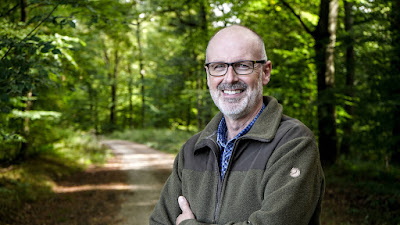The Heartbeat of Trees by Peter Wohlleben
“We often envy animals for the immediate, clear feedback their senses give them, but how aware are we of our own senses?”
THE HEARTBEAT OF TREES
A powerful return to the forest, where trees have heartbeats and roots are like brains that extend underground. Where the color green calms us, and the forest sharpens our senses.
In The Heartbeat of Trees, renowned forester Peter Wohlleben draws on new scientific discoveries to show how humans are deeply connected to the natural world. In an era of cell phone addiction, climate change, and urban life, many of us fear we’ve lost our connection to nature—but Peter Wohlleben is convinced that age-old ties linking humans to the forest remain alive and intact.
A perfect book to take with you into the woods, The Heartbeat of Trees shares how to see, feel, smell, hear, and even taste the forest.
What I thought
Peter Wohlleben invites us to join him in the forest in this fascinating read, “where we will discover that the ancient tie that binds humans and nature exists to this day and is as strong as ever.”
In the first few chapters, Wohlleben leads us to question our awareness of our own senses. He talks in depth about what we can see, hear, smell, taste, and touch. Peter informs us that we can train our senses, such as our eyesight and hearing, by spending time in nature, and also includes various exercises to activate and tune into the senses while out walking in the woods.
I enjoyed reading the chapter about fear in the forest, since I possess my own fear of being in the woods. Despite dreams of camping with friends and lifelong goals of extended thru-hikes like the Pacific Crest Trail or Appalachian Trail, I allow my fear of bears and other woodland animals to hold me back.
Wohlleben states, “The more time you spend out in the forests, the more you will get a feel for the animals that live there, how to act appropriately around them, and when you should—and should not—be concerned.” He suggests desensitization by doing nighttime hikes as a way to break down fears while at the same time giving the underused senses a good workout.
Perhaps my favourite and the most interesting part of this book for me was a chapter called First Aid from Nature’s Medicine Cabinet. In this chapter, Wohlleben talks about the way we can derive products from trees for various medications. He says, “You don’t even need to bring any headache medication into the woods, because willows offer you something similar.”
 |
| Lukasz Szmigiel, Unsplash |
Reading deeper into this, I learned that it’s because their bark contains salicin, which our bodies process into salicylic acid after ingesting. Peter recommends reaching for a cup of willow-bark tea instead of the typical synthetic medicines out there, which are more potent and come with a list of side effects. The chapter also covers cures for insect bites, bee stings, and sore throats, to name a few.
“Using nature’s medicine cabinet is not a human invention but something that connects us to our fellow creatures. If we’re rediscovering this natural medicine cabinet today, this is not a fad promoted by the environment movement but simply a return to our roots,” Peter states.
The Heartbeat of Trees encouraged me to take a mindful and refreshing walk around the gorgeous city that I feel lucky to call home. I felt a yearning for a hike around Stanley Park or Deep Cove after reading this, a desire to be close to trees, to be buried deep within the greenery of the forest, and to activate my senses. Instead, I took a walk around our residential streets, which, according to the City of Vancouver, are lined with more than 140,000 trees. Breathtaking, right?
This is definitely more of a fact-driven and scientific read requiring more attention, so bare that in mind when picking up this one up. Due to the highly scientific nature of the book, I had trouble engaging with certain parts. However, I still found what I could digest to be fascinating.
I read both the physical book, and also listened to parts of the audiobook, which is gorgeously narrated by Mike Grady. His voice is soothing, easy to understand, and perfectly fitting for Peter’s prose. The audiobook is well-paced, and definitely enhances the reading experience.
The parts of the book I did listen to on audio, I did so while I was out strolling around the streets near my apartment, which funnily enough, are all named after trees like Spruce, Oak and Pine, so that was pretty magical. I found myself intentionally paying more attention and tuning into my surroundings. I highly recommend the audiobook if you’re looking for some company on your next hike or solo camping trip.
The book was beautifully translated by Jane Billinghurst, well-researched by Wohlleben, and excellently narrated by Mike Grady. The Heartbeat of Trees is a must-read for nature lovers everywhere.
 |
| Courtesy of Peter Wohlleben |
Peter Wohlleben is the author of several books about the natural world. A longtime former forester, Wohlleben runs a Forest Academy in Germany that supports sustainable forest management and teaches adults and children about the many wonders of the forest.
